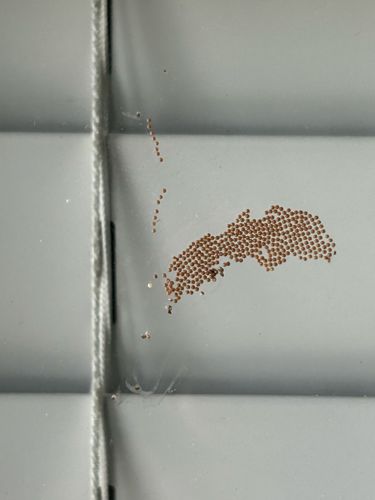Spider Eggs (likely immature spiders and remnants of egg sacs)
Scientific Name: Araneae (order)
Order & Family: Arachnida (Class), Araneae (Order); specific family/genus cannot be determined from eggs alone.
Size: Individual eggs are typically very small, well under 1-2 mm in diameter. The entire egg mass can range from a few millimeters to several centimeters, depending on the species and number of eggs.

Natural Habitat
Given the image shows translucent spherical objects and what appears to be a large cluster of very small, round brown/orange objects on an indoor surface (possibly a window or blind), these are highly likely spider eggs, possibly with some newly hatched spiderlings or remnants of an egg sac. Spiders and their eggs can be found in a variety of indoor and outdoor habitats, often in quiet, undisturbed areas such as corners of rooms, behind furniture, under eaves, or within vegetation.
Diet & Feeding
Spiderlings, depending on the species, will typically feed on small insects like fruit flies, gnats, and other minuscule arthropods shortly after hatching. Adult spiders are primarily predatory, consuming a wide range of insects and other small invertebrates.
Behavior Patterns
Spider egg sacs are typically laid in secluded, dry locations where they are protected from predators and environmental factors. The female spider creates a silk sac, lays her eggs inside, and then often guards it until the spiderlings hatch. Some species may carry the egg sac with them. Hatching spiderlings disperse shortly after emerging, often by 'ballooning' (releasing silk threads into the wind) to new locations. The image shows a large cluster of small, round eggs, indicative of an egg sac laid on a surface.
Risks & Benefits
Risks: Most spiders found in homes are harmless to humans, though some, like black widows or brown recluses, have venom that can cause medical issues. It is impossible to identify the species from eggs alone. Benefits: Spiders are beneficial predators, helping to control populations of common household and garden pests like flies, mosquitoes, and other insects.
Identified on: 8/12/2025